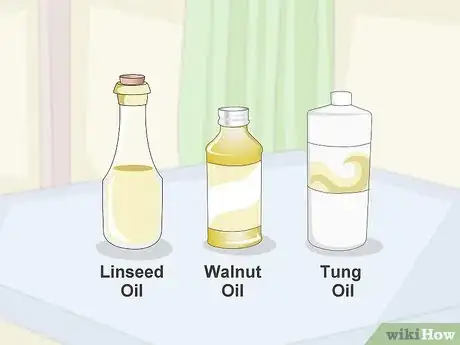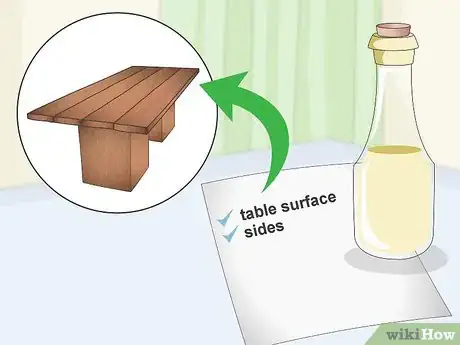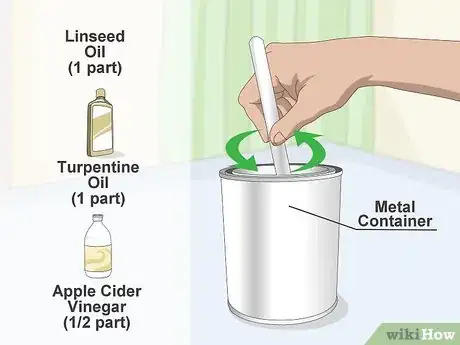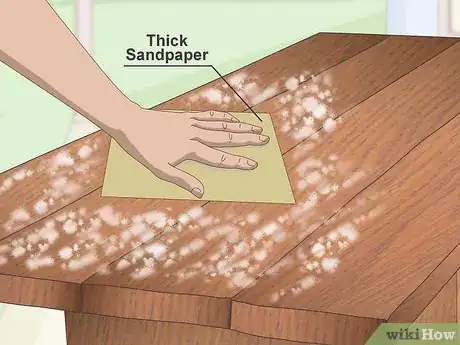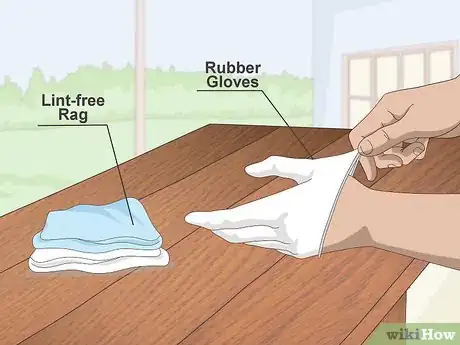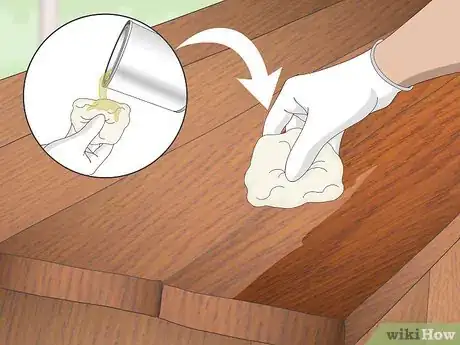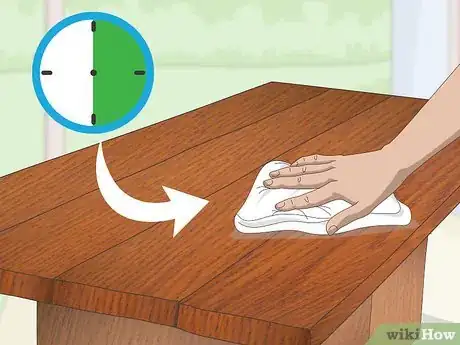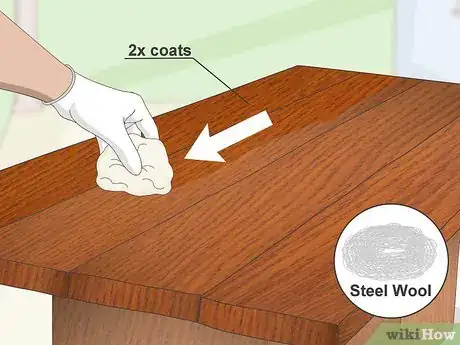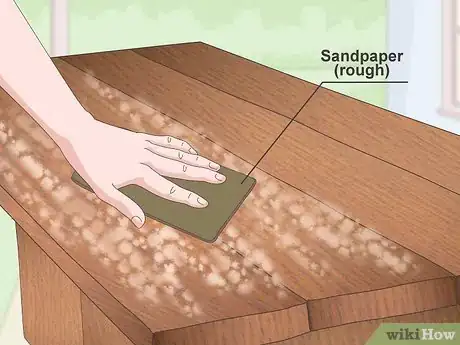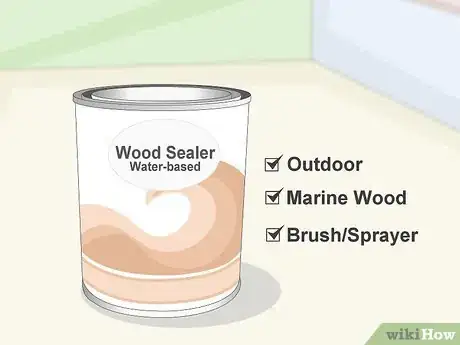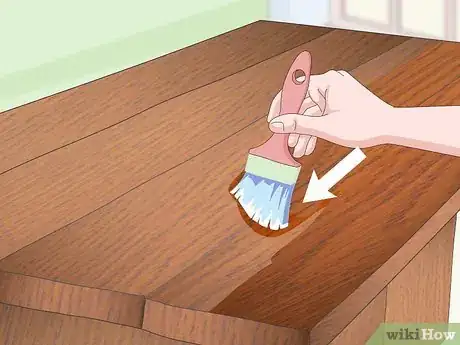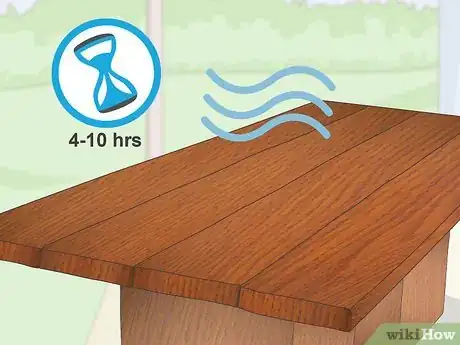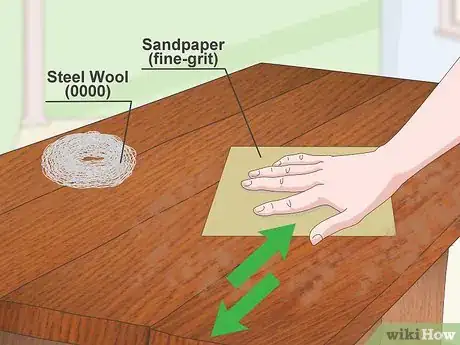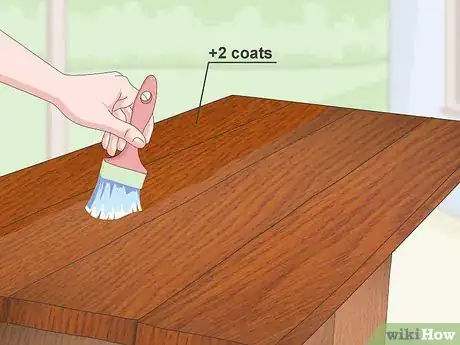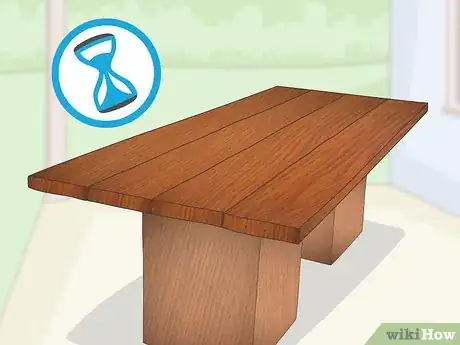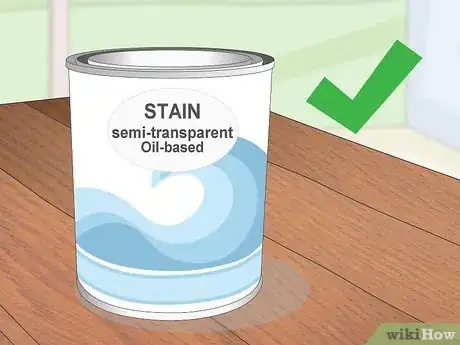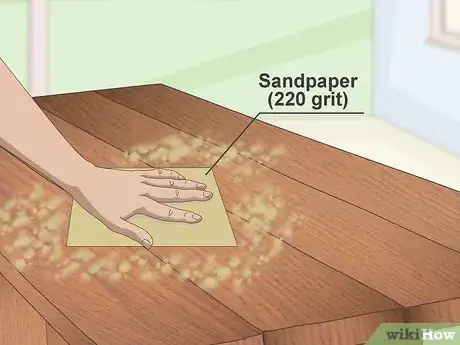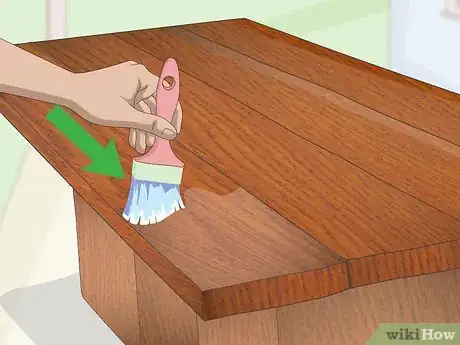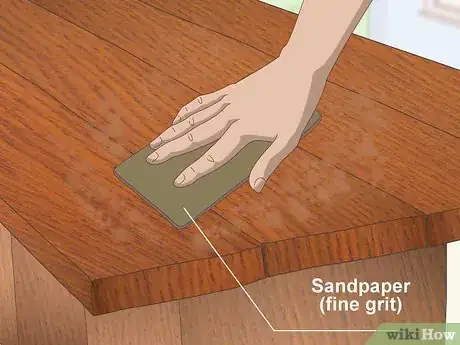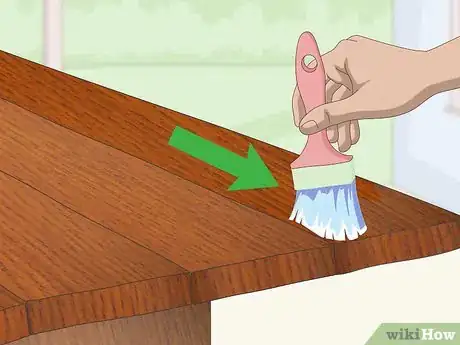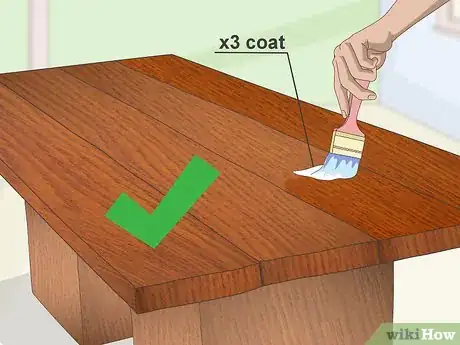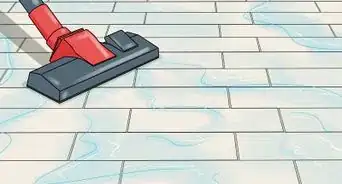This article was co-authored by Jeff Baldwin. Jeff Baldwin is a Residential Painter and the Owner of Baldwin Custom Painting. With two decades of painting experience, Jeff specializes in high-end residential and small commercial painting projects. Dedicated to quality craftsmanship, Jeff and Baldwin Custom Painting provide bonded/insured, licensed, and lead-safe certified services in residential painting, light commercial painting, and wood refinishing.
There are 7 references cited in this article, which can be found at the bottom of the page.
wikiHow marks an article as reader-approved once it receives enough positive feedback. In this case, 84% of readers who voted found the article helpful, earning it our reader-approved status.
This article has been viewed 503,375 times.
Untreated wood is susceptible to rotting, warping, or cracking. To prolong the life of your wood, you can treat it with a waterproofing product. Consider waterproofing any wood that is regularly exposed to the weather like a back patio or porch furniture. It is also common to waterproof interior-based woods and kitchen surfaces.
Steps
Waterproofing Wood with Oil
-
1Decide which oil to use. The three common oils used for waterproofing wood are linseed, walnut, and tung. Tung oil is typically found as a mix in most commercial products. Raw tung oil is often more expensive than other oils, so it is usually used on smaller wood projects. Walnut oil is the same product you’ll find next to olive oil in the grocery store. Due to nut allergies, walnut oil cannot be used commercially.
- Linseed oil can be purchased at most DIY repair shops, but many of these products are sold as raw or boiled. Boiled linseed oil contains metal drying agents that are poisonous. You can still use this product on outdoor patio equipment, but you should not use it for anything involving food.[1]
- Linseed oil can also be bought without metal drying agents. Seek out raw linseed oil if you want a safe coat on certain woods like your kitchen counter top.
-
2Purchase the oil. Scope out your project and decide which wooden surfaces you want to treat with oil. For larger projects like a patio deck, consider using an exterior stain and deck sealant. Oil is good for smaller based wooden objects like a cutting board, table, counter top, or baseball bat.
- Make a list of surfaces you want to treat. This will help you know how much oil to purchase. A good thing about treating with oil is that the oil stays good for several years.
- Purchase the oil that best suits your treating needs. Purchase a large container of oil. It is better to have too much than too little.
Advertisement -
3Create a mixture. You can create a stronger treatment and sealant by mixing the oil with turpentine and apple cider vinegar. Mix one part oil (tung, linseed, or walnut), one part turpentine oil, and ½ part apple cider vinegar. This mixture will preserve your oil supply and will create a more durable finish.
- Mix the ingredients in a metal container, like an empty coffee container. Mix the liquids until everything is blended.
- It isn’t necessary to create a mixture, but many wood enthusiasts advise this type of concoction.
-
4Prepare the wood before applying the oils. Any surface imperfections will be more noticeable after the oil is applied. The oil or oil mixture will highlight all the colors in the wood. Use thick sandpaper or a metal file for any imperfections that are visible from the surface. Scrape with the sandpaper or file until the wood looks even.
- Finish by sanding the whole surface with fine grit (220) sandpaper. This will prep the surface to absorb the oil.
- Sweep the area or rub away any scraps with a dry cloth before applying the oil. The wood must be dry before treating with oil.[2]
-
5Prepare yourself. Fold a lint-free rag and keep other scrap rags nearby. Folding the rag removes rough edges and stops potential snags when spreading the oil. Put on thick rubber gloves when handling turpentine and other products with mineral spirits.
-
6Apply the first coat. Pour a small amount of oil on the rag’s surface. Don’t apply the oil directly to the wood. Rub the oil with the grain by moving from the interior to the exterior. Be careful not to touch the oil while it’s absorbing. Concentrate on getting an even coat. Apply more oil instead of rubbing too hard to release the oil from the rag. Don’t leave any standing puddles of oil.
-
7Let the coat dry. Wait about 30 minutes for the oil to settle into the wood. Wipe the surface with a clean cloth to remove excess oil. Leave the wood to cure for 24 hours, or until it is dry. Waterproofing with oil takes longer than waterproofing with sealants.
- Rub the surface with “0000” (very fine) steel wool.
-
8Apply two more coats of oil. Apply another layer of oil onto the wood. Repeat the same drying times and sanding with steel wool. Let it cure for several days to several weeks before using the wood. You will know if it is finished being cured if you can slide your fingers across the surface smoothly.[3]
Using Sealants to Waterproof
-
1Prepare the surface. You’ll need to remove any remaining trace of past finish before using a sealant. Use sandpaper before you apply any sealants.[4] This removes finish products that may keep the sealant from absorbing. The sealant method is best for any previously finished wood, since oil-based stain may not sink into the wood.
- Use a rougher sandpaper for any areas that need more attention. Then finish sanding the surface with a finer sandpaper to ensure an even surface.[5]
-
2Purchase a water-based wood sealer. You can find these products at a home improvement stores. Water Seal and Stain Sealer are common names for wood sealants. You can also purchase a tinted sealant and sand the surface of the wood before you apply it.
- Sealants are often labeled by the type of product to which they should be applied to. For example, you may find deck sealant, fence sealant, outdoor sealant, floor sealant or furniture sealant.
- Buy a marine wood sealant if your wood needs to stand up to humidity, UV rays and water.
- Check the product to get specific application rules and dry times. Some products can be used with a paint sprayer. It is faster to apply with a sprayer.[6]
- Purchase a paint sprayer or paint brushes for application.[7]
-
3Apply an even coat. Prepare your paintbrush or sprayer and focus on creating an even coat of the surface. Make sure the temperature and humidity of the air is in the right range of the product, or the product can evaporate too quickly. Consider working in an area with a controlled humidity like a garage.
- Make sure the wood’s surface is cleaned before applying the sealant.[8]
-
4Allow the product to dry. Consult the product’s package directions for proper drying times. The drying times will be much shorter than oil’s drying times. Many sealants take between 4-10 hours.
-
5Clean the first coat. Use sandpaper with fine-grit to improve adhesion of the second coat, but only if it is recommended by the product instructions. Do this once the product has completely finished drying.
- You can also use “0000” (very fine) steel wool to clean off the sealant.
-
6Apply a second and third coat. Softwoods may need two to three coats, while some hardwoods will only need one. Softwoods are cheaper woods that haven’t been treated in the past. Popular softwoods are cedar, pine, redwood spruce, balsa, and yew. Hardwood is denser wood that is used for higher quality furniture and decks. Popular hardwood is beech, hickory, mahogany, maple, oak, and walnut.[9]
-
7Give the wood time to cure. Let the wood cure for several days before using it or placing furniture over it. When water is applied to the wood's surface, it darkens the wood instead of beading up and flowing off the surface.
- Apply the sealant every few years for healthy wood care.
Waterproofing Wood with a Stain
-
1Choose an oil-based semi-transparent stain. If you are planning on treating exterior wood, get an exterior grade stain. The lighter the stain, the more oil content the stain has. Light stains are good for interior projects or woods that won’t be exposed outdoors as much.
- These products can be found in any hardware or repair stores.
-
2Prepare the wood. Any surface imperfections will be more noticeable after the stain is applied. The stain will highlight all the colors in the wood. Use thick sandpaper or a metal file for any imperfections that are visible from the surface. Scrape the surface with the sandpaper or file until the wood looks even.
- Finish by sanding the whole surface with fine grit (220) sandpaper. This will allow the stain to be applied evenly.
- Sweep the area or rub away any scraps with a dry cloth before applying the oil. The wood must be dry before stained.[10]
-
3Apply an initial coat. Apply the stain with a paintbrush in an even fashion. Cover the entire surface and then allow it to dry. Dry the wood for four hours to one day before you apply the next coat.
-
4Remove any of the excesses. Sand the dried surface with fine-grit sandpaper. Wipe with a tack cloth to ready the surface for a second coat. It is important that the surface of the wood is dry and clean before an additional coat can be applied.
-
5Apply the second coat of stain. This coat will take slightly longer to dry. Make sure you give it plenty of time to dry so that all the waterproofing oil is absorbed. Check on the stain five hours after applying the second coat.
- You will know a coat of stain is cured when the wood is no longer sticky to the touch.
-
6Apply a third and final coat. Follow the same procedures when applying the final coats of stain. Be patient and be sure to apply even coats throughout the process. Allow three days to a week for the wood to cure before using it.
Expert Q&A
-
QuestionWhat sort of primer should I use if I want to paint wood?
 Jeff BaldwinJeff Baldwin is a Residential Painter and the Owner of Baldwin Custom Painting. With two decades of painting experience, Jeff specializes in high-end residential and small commercial painting projects. Dedicated to quality craftsmanship, Jeff and Baldwin Custom Painting provide bonded/insured, licensed, and lead-safe certified services in residential painting, light commercial painting, and wood refinishing.
Jeff BaldwinJeff Baldwin is a Residential Painter and the Owner of Baldwin Custom Painting. With two decades of painting experience, Jeff specializes in high-end residential and small commercial painting projects. Dedicated to quality craftsmanship, Jeff and Baldwin Custom Painting provide bonded/insured, licensed, and lead-safe certified services in residential painting, light commercial painting, and wood refinishing.
Residential Painter If you want to paint wood, you can use a stain-blocking primer that bonds well.
If you want to paint wood, you can use a stain-blocking primer that bonds well. -
QuestionHow can I waterproof OSB?
 Community AnswerPolyurethane is your only choice for that stuff. There's so much glue that nothing else will work.
Community AnswerPolyurethane is your only choice for that stuff. There's so much glue that nothing else will work. -
QuestionI need to waterproof a vintage school desk that will be placed on my porch exposed to the elements. What should I use?
 Community AnswerA high-quality Danish oil is your best bet. If you finish it with a clear coat afterward, let it dry at least a few days before applying a varnish and be sure to use a spar varnish (for exterior use).
Community AnswerA high-quality Danish oil is your best bet. If you finish it with a clear coat afterward, let it dry at least a few days before applying a varnish and be sure to use a spar varnish (for exterior use).
Things You'll Need
Waterproofing Wood with Oil
- Oil (walnut, linseed, or tung)
- Turpentine oil (optional)
- Sandpaper (rough and fine)
- Lint-free cloths
- Spare rags
- 0000 steel wool
Using Sealants to Waterproof
- Commercial wood sealant
- Paint brushes
- Paint sprayer (optional)
- 220-grit sandpaper
- 0000 steel wool
- Tack cloths
Waterproofing Wood with a Stain
- Oil-based stain
- Paint brushes
- Sandpaper (rough and fine)
References
- ↑ http://www.robin-wood.co.uk/wood-craft-blog/2009/12/14/what-is-the-best-oil-for-treating-wood/
- ↑ http://www.diynetwork.com/how-to/outdoors/patios-and-decks/how-to-clean-and-seal-a-deck
- ↑ http://www.woodworkdetails.com/knowledge/finishing/tung-oil
- ↑ Jeff Baldwin. Residential Painter. Expert Interview. 1 March 2021.
- ↑ http://www.wisegeek.org/what-are-the-best-methods-for-waterproofing-wood.htm
- ↑ Jeff Baldwin. Residential Painter. Expert Interview. 1 March 2021.
- ↑ http://www.wisegeek.org/what-are-the-best-methods-for-waterproofing-wood.htm
- ↑ Jeff Baldwin. Residential Painter. Expert Interview. 1 March 2021.
- ↑ http://www.diffen.com/difference/Hardwood_vs_Softwood
About This Article
To waterproof wood, start by sanding it with fine grit sandpaper to remove any imperfections and prep the surface. Then, use a rag to apply an even coat of linseed oil, walnut oil, or tung oil to the wood and let it cure for 24 hours. Repeat the process 2 more times so there are 3 coats of oil on the wood. When you're finished, let the wood cure for several days before using it. To learn how to waterproof wood with a sealant, scroll down!
